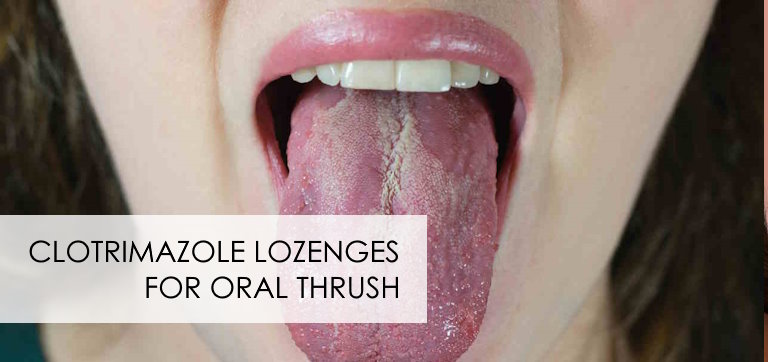Clotrimazole Lozenges for Oral Thrush – A Comprehensive Guide
Table of Contents
Clotrimazole lozenges are used for the treatment of oral yeast infections in both adults and children aged three years and above. Additionally, they are used in the prevention of oral yeast infections among high-risk individuals due to specific treatment regimens such as chemotherapy.
In this guide, we will explore the therapeutic applications, clinical considerations, side effects and commonly asked questions related to the use of clotrimazole lozenges in managing oral thrush.
What are Clotrimazole Lozenges?
Clotrimazole lozenges are used to treat oral thrush, a condition caused by the overgrowth of Candida fungus in the mouth. They are composed of clotrimazole, an antifungal agent belonging to the class of imidazoles. Oral thrush commonly presents as white, creamy patches on the tongue, inner cheeks, gums, and tonsils.
Clotrimazole lozenges provide a localized treatment approach, allowing the medication to directly target the affected areas within the mouth. This targeted delivery enhances the efficacy of clotrimazole tablet in eliminating the fungal infection while minimizing systemic exposure and potential side effects.
-
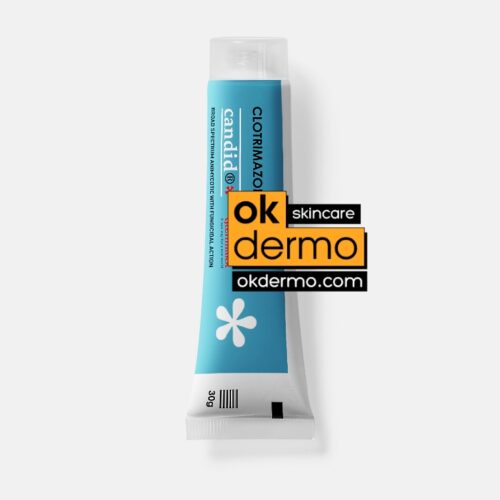
Candid® Clotrimazole Cream / Powder
Clotrimazole 1% / 2%, Beclometasone, Ofloxacin, Ornidazole, Terbinafine, Clobetasol, Miconazole, Neomycin
Size: 20g / 0.7oz
Brand name: Canesten, Lotrimin, Gyne-Lotrimin, Diprolene, Luxiq, Floxin, MetroGel, Lamisil AT, Temovate, Dermovate, Clobex, Olux, Monistat, Micatin, Neo-Synalar
From USD $18.00 Select options -
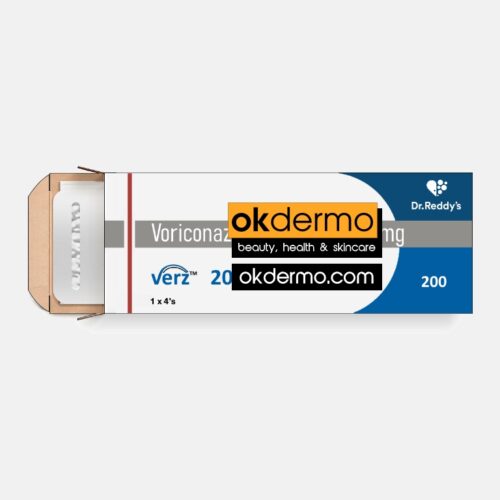
Verz® Voriconazole Tablets
Voriconazole 50mg / 200mg
Size: 4 Tablets
Brand name: Vfend
From USD $26.00 Select options -
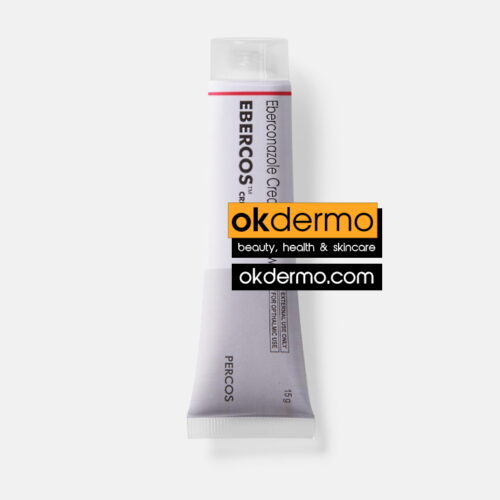
Ebercos® Eberconazole Cream
Eberconazole 1%
Size: 15g / 0.53oz
USD $22.00 Add to cart -
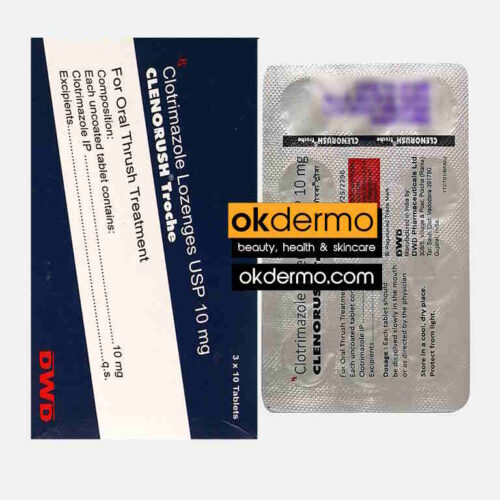
Clenorush Troche® Clotrimazole Lozenges
Clotrimazole 10mg
Size: 30 Lozenges
Brand name: Canesten, Clotrimaderm, Desenex, Myclo-Derm, Neo-Zol, Clotrim, Antifungal, Cruex, Lotrimin, Mycelex
USD $38.00 Add to cart
How Do Clotrimazole Lozenges for Oral Thrush Work?
Clotrimazole lozenges, also called oral thrush lozenges, exert their antifungal effects through a mechanism of action that specifically targets the underlying fungal infection within the oral cavity. The active ingredient, clotrimazole, interferes with the fungal cell membrane’s integrity, leading to the inhibition of fungal growth and ultimately resulting in cell death.
Clotrimazole belongs to a class of antifungal medications known as imidazoles. It works by inhibiting the enzyme lanosterol 14α-demethylase, which is essential for the synthesis of ergosterol, a crucial component of fungal cell membranes. By blocking this enzyme, clotrimazole disrupts the synthesis of ergosterol, thereby compromising the structural integrity and function of the fungal cell membrane.
As a consequence, the fungal cell membrane becomes weakened, leading to leakage of intracellular contents and impairment of vital cellular processes. This disruption ultimately leads to the death of the fungal cells, halting the progression of the infection.
Clotrimazole Lozenge – How to Use?
Step-by-Step Guide on Proper Usage:
- Wash Hands: Before handling the clotrimazole tablet, ensure that your hands are clean and dry to prevent contamination.
- Remove Lozenge from Packaging: Carefully remove the clotrimazole lozenge from its packaging, taking care not to damage or break it.
- Place Lozenge in Mouth: Place the oral thrush lozenge in your mouth and allow it to slowly dissolve. Avoid chewing or swallowing the lozenge whole, as it is designed to dissolve slowly and release the medication over time.
- Allow Proper Dissolution: To maximize the effectiveness of the medication, refrain from eating or drinking for at least 30 minutes after using the lozenge to allow for proper absorption.
- Do Not Rinse Mouth Immediately: Avoid rinsing your mouth immediately after using the oral thrush lozenge, as this may wash away the medication before it has had a chance to take effect.
Dosage Instructions for Adults and Children:
- Adults: The typical dosage for adults is one clotrimazole lozenge (10 mg) taken five times daily for the treatment of oral thrush.
- Children: For children aged 3 years and older, the dosage may vary depending on their age and weight.
- Prophylactic Administration: For prophylaxis, 10 mg is taken orally three times daily throughout the chemotherapy regimen or until steroid dosage is tapered to maintenance levels.
Duration of Treatment and Frequency of Administration:
- The duration of treatment with clotrimazole tablet may vary depending on the severity of the oral thrush and individual response to the medication. Typically, treatment with clotrimazole lozenges may last for 7 to 14 days.
- It is important to complete the full course of treatment as prescribed by your healthcare provider, even if symptoms improve before the treatment is finished.
- Clotrimazole lozenges are usually administered five times daily, with approximately four hours between each dose. It is essential to adhere to the prescribed dosing schedule to ensure optimal therapeutic outcomes and prevent the recurrence of oral thrush.
Clotrimazole Lozenge Side Effects
Common Clotrimazole Lozenge Side Effects:
- Oral Irritation: Some individuals may experience mild irritation or discomfort in the mouth, including a burning sensation or soreness.
- Changes in Taste: Clotrimazole lozenges may alter taste perception, leading to a metallic or bitter taste sensation.
- Nausea: Nausea and gastrointestinal discomfort may occur in some individuals, although these side effects are typically mild and transient.
- Dry Mouth: Dryness of the mouth or throat may occur as a result of using a clotrimazole tablet, leading to thirst or discomfort.
Rare but Severe Clotrimazole Lozenge Side Effects:
- Allergic Reactions: Although rare, some individuals may experience allergic reactions to clotrimazole oral thrush lozenges, presenting with symptoms such as rash, itching, swelling of the face or throat, difficulty breathing, or severe dizziness. Immediate medical attention is necessary if any signs of an allergic reaction occur.
- Severe Oral Irritation: In rare cases, clotrimazole lozenges may cause severe oral irritation or ulceration, leading to pain, swelling, or difficulty swallowing. Discontinue use and consult a healthcare provider if these symptoms occur.
Precautions and Considerations
Factors to Consider Before Using Clotrimazole Lozenges:
- Underlying Medical Conditions: Individuals with certain medical conditions, such as diabetes or immune system disorders, should consult a healthcare provider before using a clotrimazole tablet. Special precautions may be necessary to ensure the safe and effective use of the medication in these populations.
- Allergies: Patients with a known allergy to clotrimazole or any other components of the oral thrush lozenges should avoid using the medication. Allergic reactions to clotrimazole lozenges can range from mild skin irritation to severe symptoms such as difficulty breathing and swelling of the face or throat.
- Pregnancy and Breastfeeding: Pregnant or breastfeeding women should consult their healthcare provider before using clotrimazole oral thrush lozenges. While clotrimazole tablet is generally considered safe during pregnancy and breastfeeding, caution is advised, and the potential risks and benefits should be discussed with a healthcare professional.
- Children and Elderly: Clotrimazole lozenges are suitable for children aged 3 years and older under the supervision of a healthcare provider. However, special considerations may apply to pediatric or elderly populations, and dosage adjustments may be necessary based on age and weight.
Interactions with Other Medications or Medical Conditions:
- Drug Interactions: Clotrimazole oral thrush lozenges may interact with certain medications, including anticoagulants (e.g., warfarin) and oral hypoglycemic agents (e.g., glyburide). Concurrent use of clotrimazole lozenges with these medications may potentiate or inhibit their effects, leading to potential complications. It is essential to inform your healthcare provider about all medications, supplements, and herbal products you are taking to prevent potential interactions.
- Oral Hygiene Products: Avoid using certain oral hygiene products, such as mouthwashes containing alcohol or abrasive toothpaste, immediately before or after using clotrimazole lozenges for oral thrush. These products may reduce the effectiveness of the medication or cause irritation to the oral mucosa.
- Medical Conditions: Individuals with certain medical conditions, such as liver disease or compromised immune function, may require close monitoring while using clotrimazole lozenges for oral thrush. In some cases, dosage adjustments or alternative treatment options may be necessary to minimize the risk of adverse effects or complications.
Frequently Asked Questions (FAQs) About Clotrimazole Lozenges
Can you buy clotrimazole lozenges over the counter?
Yes, clotrimazole lozenges for oral thrush are available over the counter (OTC) in many countries. This means that you can purchase them without a prescription from a healthcare provider. However, it’s essential to read and follow the instructions provided on the product packaging or consult a pharmacist for guidance on proper usage and dosage.
What is clotrimazole lozenge used for?
Clotrimazole lozenges are primarily used for the treatment of oral yeast infections, commonly known as oral thrush. Oral thrush is caused by an overgrowth of Candida fungus in the mouth, leading to symptoms such as white patches on the tongue, inner cheeks, gums, and tonsils, as well as discomfort and soreness. Clotrimazole lozenges for oral thrush work by targeting the underlying fungal infection, inhibiting the growth of Candida species responsible for oral thrush, and promoting the resolution of symptoms.
How long does it take for clotrimazole lozenges to work?
The time it takes for clotrimazole lozenges for oral thrush to work can vary depending on the severity of the oral thrush and individual response to the medication. In general, clotrimazole lozenges typically start to alleviate symptoms within a few days of initiating treatment. However, it’s essential to complete the full course of treatment as prescribed, even if symptoms improve before the treatment is finished. This helps ensure the complete eradication of the fungal infection and reduces the risk of recurrence.
Why is clotrimazole not given orally?
Clotrimazole is primarily available in topical formulations, such as creams, ointments, and lozenges, for the treatment of localized fungal infections. While clotrimazole is effective against a wide range of fungal pathogens, its oral bioavailability is limited when taken orally, meaning that only a small fraction of the medication is absorbed into the bloodstream after oral administration. As a result, oral formulations of clotrimazole are not commonly used, as they may not provide adequate systemic exposure to effectively treat systemic fungal infections. Instead, topical formulations, such as clotrimazole lozenges, are preferred for localized fungal infections, including oral thrush, as they allow for direct application to the affected area, enhancing the medication’s efficacy and minimizing systemic exposure and potential side effects.
References:
- https://www.researchgate.net/profile/Bhawna-Sharma-20/publication/357656945_CLOTRIMAZOLE_A_REVIEW_OF_ITS_STRUCTURE_THERAPEUTIC_CLASS_AND_PHARMACEUTICAL_PROPERTIES_PHARMACEUTICAL_DOSAGE_FORMS_AND_ADMINISTRATION_AND_ANALYTICAL_STUDY/links/61d841efe669ee0f5c8f0914/CLOTRIMAZOLE-A-REVIEW-OF-ITS-STRUCTURE-THERAPEUTIC-CLASS-AND-PHARMACEUTICAL-PROPERTIES-PHARMACEUTICAL-DOSAGE-FORMS-AND-ADMINISTRATION-AND-ANALYTICAL-STUDY.pdf
- https://academic.oup.com/jambio/article/117/3/611/6716537#383456195
- https://exodontia.info/wp-content/uploads/2021/07/Int_J_Pharmacy_Pharmaceutical_Sciences_2010._Oral_Candidiasis_-_A_Review.pdf
- https://www.nejm.org/doi/full/10.1056/NEJM197811302992201
- https://jamanetwork.com/journals/jamainternalmedicine/article-abstract/604094
- https://europepmc.org/article/nbk/nbk560643
Post by:
Dr.Marcella Jiovanni
Health and Beauty Expert
“Marcella Jiovanni actively promotes the importance of maintaining healthy skin, she envisions the future of dermatology as moving away from pure medical, pharmacological dermatology and flowing more toward a holistic approach to wellness and skincare.”

